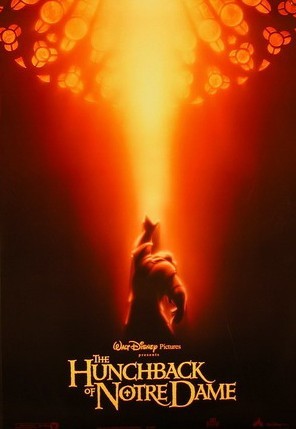Plot:Set in medieval Paris, Judge Claude Frollo (a priest in the original) has his soldiers rounding up the city's gypsy population in an effort to "cleanse" the city. After chasing after one of the runaways and killing her on the steps of the Notre Dame cathedral, Frollo saw that the woman was carrying her infant child. But when an almost repentant Frollo saw how ugly the baby was, he attempts to drown it. But the archdeacon shows Frollo how he may never see heaven, and tells him he must now care for child and raise him as his own. Frollo agrees, on the condition that the baby be allowed to remain in the bell tower.
20 years later, the infant Quasimodo grew into a hunchbacked bell ringer, who could only dream about being able to leave his home and join the people in the streets. The Feast of Fools was today, and Quasimodo's "imaginary" gargoyle friends convinced him to leave his sanctuary. Down on the streets, Captain Phoebus returns from fighting in the Hundred Years War and is named Frollo's new Captain of the Guard.
During the festival, all three men are captivated by the gypsy woman Esmeralda. While Quasimodo's love is innocent and Phoebus's is truthful, Frollo's is simply pure lust, which he thinks is due to Satan's temptations. Frollo vows that if he cannot have her, he would kill her. Frollo leads a witch hunt throughout Paris, which leads Phoebus to act against the mad judge. Now, it's up to Phoebus and Quasimodo to protect Esmeralda and her gypsy friends from the lust filled Judge.
What's Bad?: Like Fantasia, the film may not be the best for little kids. The film doesn't have any of the basic 90's film ideas or mentalities. It is trying to attract the adult audience, who had been avoiding animated films until Beauty and the Beast. But the problem is that while it tries to bring in a new audience, it doesn't do much for the basic Disney audience.
The romance between Phoebus and Esmeralda isn't very interesting. While I will admit it is necessary when telling the story to have the idea that the main character doesn't always get the girl, but it could have been explored more.
The gargoyles, while necessary to tell the plot, could have been a lot less annoying. This film has the distinction of starting the animated film cliche of having a really annoying sidekick, either good or bad, that wasn't funny. The following three films would all fail to recapture the magic of Robin Williams' performance as the Genie. In this case, Jason Alexander, Mary Wickes, and Charles Kimbrough bring nothing but a failed Genie re-imagining.
What's Good?: As with the case of Sleeping Beauty, the stuff that is good in this movie is really good. Let's start with one of two villain performances that could contend with Jeremy Irons for the Best Disney Villain award. Judge Frollo is a horrible and evil human being, but he justifies his actions by telling the world and himself that his actions were divine planning. You usually don't have a villain like this who is an avid murderer and Christian in a Disney movie. You usually get a Jafar or an Ursula, who you know probably sold their souls to get the powers they have.
Quasimodo is also a very good performance. After his brilliant work in Amadeus, Tom Hulce was brought in to portray a very human and caring hunchback. Hulce is able to bring a new side to Quasimodo, with portraying him as a socially stunted man who manages to create these vivid delusions of grandeur with his imaginary gargoyle friends.
The songs are very different from the previous few films. Though Alan Menken and Steven Schwartz do return following their success with Pocahontas, they wrote a very different list of songs and a new score idea. The two best songs in the film, "The Bells of Notre Dame" and "Hellfire", do what songs in a musical are supposed to do: tell us how the character is feeling while not detracting from the plot. Even the score is really good. Similarly to how Hans Zimmer used Zulu choirs in
The Lion King, Menken makes good use of his Latin choirs to give the film a strong epic tone while also keeping the film grounded in it's highly religious setting and tone.
Overall: This one is a classic. I personally believe that so long as you give the audience a happy ending, children can handle anything, especially following a movie where the father is killed on screen. The songs are good enough to merit listening to, and the animation is still beautiful. This is a must see for any Disney fan, and a "should" see for the casual movie goer.
Report Card
Hero: A
Heroine: A-
Villain: A+
Side Characters: B-
Songs: B+
Musical Score: A+
Animation: A
Special Effects: B+
Themes: A+
Story: A+
Final Grade: A-

No comments:
Post a Comment